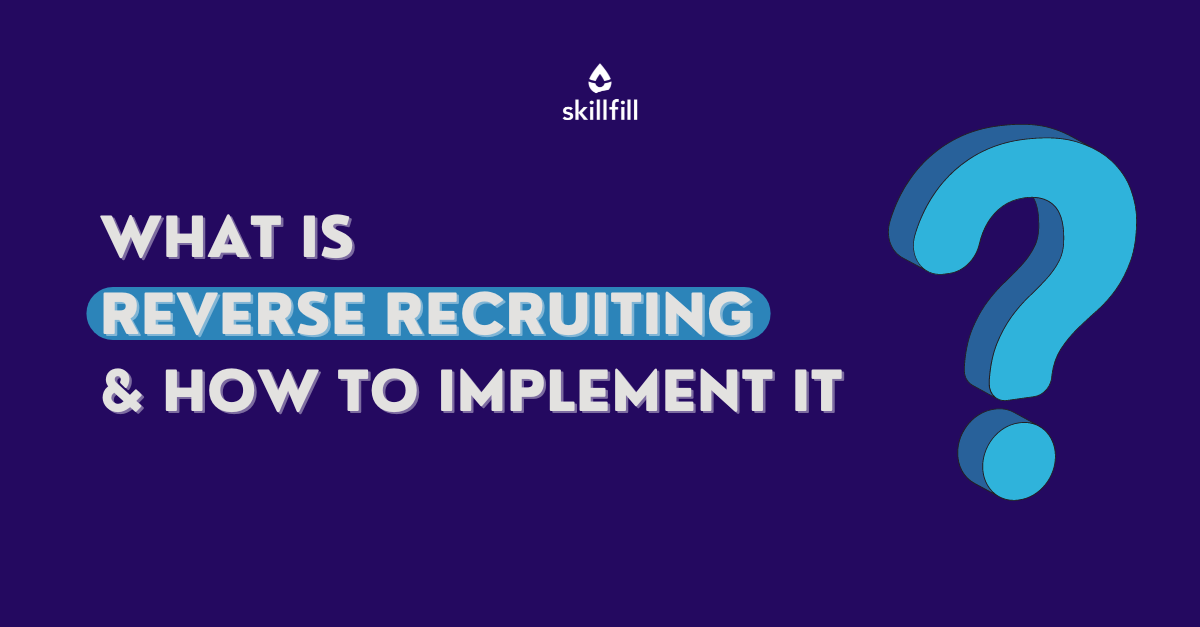Reverse Recruiting: A Fresh Approach to Talent Acquisition
Reverse Recruiting: A Fresh Approach to Talent Acquisition
Blog Article
Unlock the Power of Reverse Hiring Techniques for Effective Talent Acquisition
In the realm of ability acquisition, the landscape is regularly evolving, with new approaches emerging to satisfy the needs of a competitive market. Among these methods, reverse recruiting stands out as a method that turns the typical recruitment process on its head, putting the power in the hands of the prospects. By tempting leading talent to seek out chances within your company, reverse recruiting supplies a fresh approach to attracting and keeping key personnel. As companies aim to remain in advance in the skill video game, opening the potential of reverse recruiting strategies could be the key to protecting a strong and vibrant labor force.
Understanding Reverse Recruiting
Recognizing reverse recruiting is crucial in browsing the advancing landscape of talent acquisition methods. Unlike traditional recruitment approaches where companies choose candidates, reverse recruiting entails the proactive strategy of prospects looking for potential employers. This paradigm shift puts candidates in the driver's seat, enabling them to pick companies that align with their values, career objectives, and work preferences.
Fundamentally, reverse recruiting equips prospects to take control of their task search procedure by researching firms, reaching out to employers or working with managers straight, and showcasing their skills and experiences. For employers, this strategy offers a special chance to bring in leading skill that are genuinely interested in the business and its goal, cultivating a much more involved and committed workforce.
Benefits of Reverse Hiring
Employing reverse recruiting techniques can generate substantial advantages for both prospects and companies in the talent purchase procedure. By being come close to by employers who have currently recognized them as possible fits for their organization, prospects can really feel a lot more valued and sought after.
Furthermore, reverse recruiting can assist companies separate themselves in an affordable talent market by showcasing a proactive and forward-thinking method to employment. Eventually, the advantages of reverse recruiting expand to both candidates and companies by simplifying the employing process and cultivating more meaningful links between the 2 parties.

Implementing Reverse Recruiting Strategies
To successfully incorporate reverse recruiting methods right into an ability procurement strategy, companies must prioritize positive interaction with prospective prospects. This involves determining top skill within the sector and developing partnerships with them prior to an actual job opening arises. One essential strategy is to leverage social media systems to attach with easy candidates who may not be proactively looking for new opportunities. By showcasing the firm society, values, and profession development opportunities, companies can stimulate the interest of possible prospects and develop a find more info skill pipeline for future demands.
Furthermore, applying customized communication approaches can also improve the performance of reverse recruiting. By consistently nurturing connections with leading ability, companies can remain ahead in the affordable ability acquisition landscape and protect the finest prospects for their group - reverse recruiting.
Leveraging Modern Technology backwards Recruiting
In the digital age of skill purchase, using technical advancements is critical for successful application of reverse recruiting approaches. Leveraging modern technology backwards recruiting supplies countless advantages to streamline the procedure and attract top ability effectively. Applicant radar (ATS) play an essential role in managing candidate data, tracking interactions, and automating interaction, permitting employers to concentrate on building relationships with potential hires.
Utilizing information analytics websites devices can aid employers determine the efficiency of their reverse recruiting techniques, recognize areas for enhancement, and make data-driven choices to optimize the talent procurement process - reverse recruiting. By welcoming technology in reverse recruiting, organizations can remain ahead in the competitive skill market and secure top skill successfully.
Determining Success backwards Recruiting
Having developed the fundamental duty of technology in enhancing reverse recruiting strategies, the next crucial step hinges on properly measuring the success of these innovative methods. In the world of reverse recruiting, traditional metrics like time-to-fill and cost-per-hire may not fully catch the effect of these approaches. Rather, measuring success in reverse recruiting needs a much more nuanced technique that concentrates on prospect involvement, company branding improvement, and long-term skill retention.
One secret metric to think about is prospect experience. By gathering feedback from candidates that have undergone the reverse recruiting process, companies can obtain valuable insights into areas for improvement and recognize staminas to utilize. Additionally, tracking metrics connected to employer brand perception, such as social networks belief and Glassdoor evaluations, can offer a much more holistic sight of just how reverse recruiting is forming the organization's reputation in the talent market.
Inevitably, success backwards recruiting should be determined not only by the performance of loading functions but also by the top quality of hires, their alignment with business culture, and their long-lasting efficiency within the business. By taking on a thorough technique to determining success, companies can truly unlock the potential of reverse recruiting methods for effective talent procurement.
Final Thought

Report this page